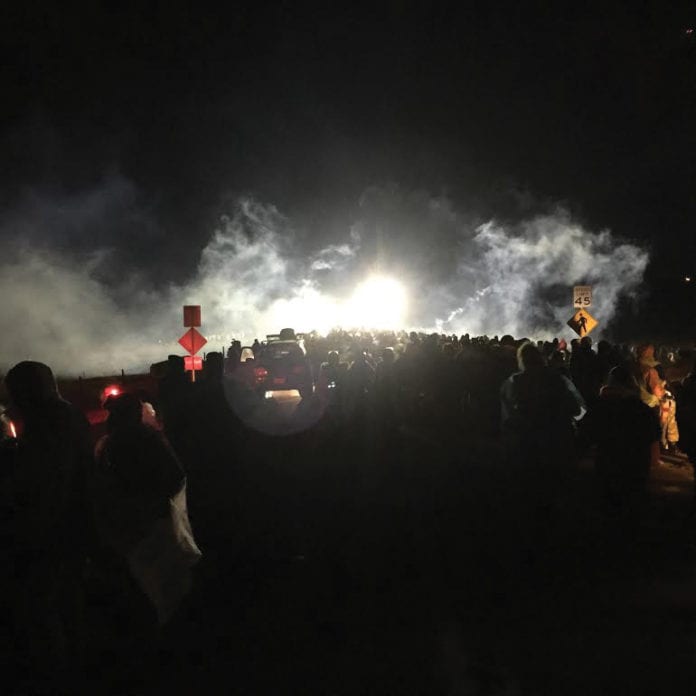
By Daysha Eaton
KBBI — Homer
On the chilly plains of North Dakota, organizers estimate that around 2,500 people are now gathered near the Standing Rock Sioux reservation to support the Great Sioux Nation, or Oceti Sakowin, in their efforts to stop an oil pipeline from crossing under the Missouri River near their reservation. The demonstrators, who call themselves water protectors, say they have been facing increasing violence from local law enforcement. Recently, two Athabascan men from Alaska visited the camps in Cannonball, ND.
Demonstrators who call themselves water protectors faced law enforcement officers who fired rubber bullets and water cannons in below freezing temperatures near Cannon Ball, ND on the evening of Sunday, Nov. 20. (Photo courtesy of Tracy Peterson)
Demonstrators who call themselves water protectors faced law enforcement officers who fired rubber bullets and water cannons in below freezing temperatures near Cannon Ball, ND on the evening of Sunday, Nov. 20. (Photo courtesy of Tracy Peterson)
Some people participate in direct actions– peaceful protests near the path of the pipeline. Samuel Johns an Anchorage resident who is Ahtna and Gwich’in Athabascan, originally from Copper Center, said that’s where the trouble comes in.
“They are unarmed,” Johns said. “They just want to protect the water and they are being maced, they are being shot by rubber bullets.”
On Nov. 20, demonstrators reported being shot by law enforcement with rubber bullets and water cannons in below freezing temperatures. Organizers report several went to the hospital for treatment.
The $3.7 billion, nearly 1,200-mile long pipeline is being built by a Texas-based corporation called Energy Transfer Partners. In order to complete the pipeline, the company wants to drill under the Missouri River. The pipeline would ship crude oil across four states.
In addition to reporting that they were hit with rubber bullets and water cannons on the evening of Sunday, Nov. 20, demonstrators near the Standing Rock Sioux Reservation in North Dakota also reported that officers launched tear gas, mace and concussion grenades into the crowd. (Photo courtesy of Tracy Peterson)
In addition to reporting that they were hit with rubber bullets and water cannons on the evening of Sunday, Nov. 20, demonstrators near the Standing Rock Sioux Reservation in North Dakota also reported that officers launched tear gas, mace and concussion grenades into the crowd. (Photo courtesy of Tracy Peterson)
The tribe said the pipeline is a threat to their water supply and that construction threatens sacred sites. The federal government has halted construction, but the companies building the pipeline have asked a federal court to let them complete the project.
Fred John Jr. an Ahtna Athabascan elder from Delta Junction, also traveled to the camp. John says he is also concerned that local law enforcement are overstepping their authority.
“They come with their stick, they come with their mace against peaceful protectors,” John said. “And it doesn’t seem right to me. We have more right to be on that land. It’s tribal land plus contested treaty land.”
Demonstrators have been occupying privately-owned land in the path of the pipeline, claiming that they are the land’s rightful owners under an 1851 treaty with the U.S. Government.
The men say they hope to return to Standing Rock soon with a group to help with construction and winterization projects before the bitter North Dakota winter sets in.














